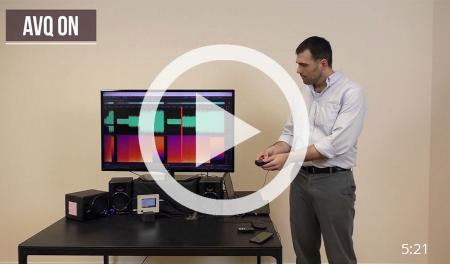Alango PersonaSound™ concept.
Part 1 - General.
Watch this video on Alango Youtube Channel
Doesn't an audio track created by a talented musician and played through an excellent sound system tuned to the “golden years” meet our needs? In this video, you will learn why that's not the case. In the next videos, I will explain how we can personalize the sound for our hearing, our device, our content, our environment and our preferences.
Alango PersonaSound™ Concept.
Part 2 - Personalization for an individual hearing.
Watch this video on Alango Youtube Channel
After watching this video you will understand why and how audio devices need to be personalized for the user’s hearing, what a hearing loss is, why it can not be compensated for by a volume and frequency equalizers...
Alango PersonaSound™ Concept.
Part 3 - Personalization for a device.
Watch this video on Alango Youtube Channel
After watching this video, you will know why and how sound can be personalized or optimized for certain devices that are most likely different from the device that was used for mastering. Three options are considered...
Alango PersonaSound™ Concept.
Part 4 - Personalization for the current environment.
Watch this video on Alango Youtube Channel
After watching this video, you will know why and how sound can be dynamically modified and optimized for the user’s current acoustic environment, where noises change rapidly in strength and spectrum. Never miss a word in a phone call again...
Alango PersonaSound™ Concept.
Part 5 - Personalization for individual preferences.
Watch this video on Alango Youtube Channel
Two people with healthy hearing listening to the same audios or podcasts in the same place and with the same device may have different preferences. After watching this video, you will know why and how audio and speech can be dynamically customized to the user’s specific preferences...
Making sound personal - Alango PersonaSound™ concept explained
Watch this video on Alango Youtube Channel
After watching this presentation, you will know why and how sound can be personalized for your hearing, your device, your acoustic environment, the content you listen to, and even your personal preferences. I’ve tried to make the content as simple as possible. Even if you have no prior knowledge of audiology or digital signal processing, you will understand the principles...
AVQ Demonstration - Alango Automatic Volume and Equalization for music enhancement
Watch this video on Alango Youtube Channel
Wouldn’t it be great if there were a way to automatically control both the volume and equalization according to the noise characteristics of your environment? We at Alango have developed such technology--and we demonstrate it in this video.
Music sounds better with MuRefiner
Glenn Miller - Chattanooga Choo Choo (Converted to stereo)
Demonstration of Alango mono-to-stereo music enhancement. Original mono sound was extracted, converted to stereo and enhanced by Alango Technologies algorithms and software.
Rammstein - Bück dich (LIVE) (Converted to stereo)
Demonstration of Alango mono-to-stereo music enhancement for a video clip recorded by a smartphone (iPhone). Original mono audio was extracted and processed by Alango Technologies algorithms and software.
Fred Astaire - Puttin On The Ritz (Converted to Stereo)
Demonstration of Alango mono-to-stereo music enhancement. Original mono sound was extracted, converted to stereo and enhanced by Alango Technologies algorithms and software.
Ray Charles - Hit The Road Jack (LIVE) (Converted to stereo)
Demonstration of Alango mono-to-stereo music enhancement. Original mono audio was extracted, converted to stereo and enhanced by Alango Technologies algorithms and software.
Louis Armstrong - Hello Dolly (LIVE) (Converted to stereo)
Demonstration of Alango technology for converting mono sound to stereo with additional enhancement.
Alango Automatic Volume and Equalization (AVQ) technology for in-car music enhancement
Watch this video on Alango's Youtube Channel
When driving, do you feel like you're always turning your music volume up or down to cope with the changes in background noise? Do music and phone calls sound muddy, shrill, or unbalanced during your drive? Does your in-car automatic volume control get the job done, or do you still end up making manual adjustments in changing noise conditions? Alango's Automatic Volume and Equalization technology (AVQ) is here to help. Unlike speed-dependent volume control in cars (which only roughly estimates noise level based on current driving speed), AVQ uses a microphone to directly measure ambient noise level and spectrum (frequency). But AVQ does more than just automatic volume adjustment for music and phone calls. AVQ also equalizes the sound based on the spectrum of the background noise. Inside the car--where noise level and spectrum are always changing--AVQ ensures equal perceptual loudness, sound coloration, and voice intelligibility without any need for manual adjustment.








 &duration=4:34)

||(Converted to stereo)&duration=3:37)
&duration=4:31)

||(Converted to stereo)&duration=2:25)

||(Converted to stereo) &duration=2:30)
 technology for in-car music enhancement&duration=4:22)